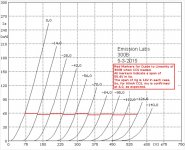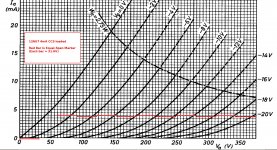I don't see where he claimed that. However, the high rp of a 12AX7 makes things difficult. If one follows the "10 x rp" Rule of Dumb, we have to drop 600-800V across the anode resistor.
He did not claim the AX7 had Ra = 10K, no.
But answering my criticism of his Ra = 10K, RL = 100K stage by saying "use a 12AX7" is simply twisting the argument.
I don't see where he claimed that. However, the high rp of a 12AX7 makes things difficult. If one follows the "10 x rp" Rule of Dumb, we have to drop 600-800V across the anode resistor.
I didn't say the load had to be 10X Ra. I just gave you examples to show how minute the improvement would be if you did.
As I pointed out, (backed up by Mullard tube data) the 12AX7 has much lower distortion, so there is less need for a high anode load. One fith of 1 quarter of stuff all, as the saying goes, mate.
Instead on making unsubstantiated claims, why don't you consult some tube curves and calculate what the distortion will be with realistic anode load resistors and HT.
Last edited:
Instead on making unsubstantiated claims, why don't you consult some tube curves and calculate what the distortion will be with realistic anode load resistors and HT.
This may sound absolutely cray-cray, but I actually MEASURE these things before making proclamations. I know, nuts.
He did not claim the AX7 had Ra = 10K, no.
But answering my criticism of his Ra = 10K, RL = 100K stage by saying "use a 12AX7" is simply twisting the argument.
Well, it's certainly shifting goalposts, but that's part of the tactical pattern. Along with derailing the thread topic.
In any case, the 12AX7 is very linear in the right circuit, but far less so in the practical circuits where its been applied. CCS helps that a lot, but carries other penalties and still requires that the output of the tube be buffered.
This may sound absolutely cray-cray, but I actually MEASURE these things before making proclamations. I know, nuts.
So, what is the data from those measurements? How were they made? Details? Evidence?
You don't need to put any trust in me. I put up data taken straight off the curves in the Mullard databook. You can replicate what I did for yourself.
Do you think that Mullard made their tube curves up?
Some of us read books and stop there. Others use what they learn and do experiments.
.. and experiments may become real working amplifiers - even original, new work. Schematics may be posted, and the purpose of DIYaudio fulfilled. I know I have shared a few items of original work.
Apropos which - Keit, I do not remember seeing any original design presentations from you. Is this really so, or have you posted schematics and design descriptions for us to see?
I have Youth Spies who load me up with stuff like that.
Me too!!! "cray-cray" was in my dossier. They also gave me sum purple drank but I didn't like the taste of it
But I do agree with you that tube regulators are more of a frippery, which is why I use solid state regs. (no offense intended, KK)
I also prefer solid state regulators; no offence intended either for my part, Kevin.
From a few years I use a monstrous MOSFET, commonly used in old big Philips TVs, with gfs=9.6 S (Typ) with great success.
Did SY just say cray-cray?
SY can be very funny, but from this side of the world sometimes it can be a challenge, I must go to Urban Dictionary, nothing to say when he add some Yiddish
And do not stint on the power supply; the PSR of the cascodes is 67% of bupkis.
Sorry, my Spanish is limited to simple greetings, simple questions, and vile curses. So you very much have the better of me.
Apropos which - Keit, I do not remember seeing any original design presentations from you. Is this really so, or have you posted schematics and design descriptions for us to see?
No answer, comes the bold reply.
So, Keit. You claim to have decades of "professional" experience, and have all the answers, and yet you have no designs and no original work to show us. No amplifiers, no schematics, nothing at all.
Instead, you wish to indulge yourself in abusing and sneering at the work of everyone else here - often in arrogant and discourteous language - but when it comes to allowing your comrades the chance to pay the same respects to you, the door is closed. A cowardly tactic, for sure. In real professional circles, the peer review is a mutual affair.
that is a weak excuseunless he worked for national security
As in - designing the high-security State Tube Amplifier (with encryption)?
Anyone pretending to 'know it all' can always post the schematic of the system they use at home. Or post a schematic to illustrate a technical argument.
But when vague descriptions take the place of schematics, we witness the (highly disingenuous) practice of saying that any person challenging his ideas is "misinterpreting" what he stated. IOW, Constantly moving goal-posts.
And BTW, When my customers' designs are commercially confidential, I do not even mention they exist, least of all in a public forum.
You'll find you don't get 0% distortion at constant anode current
Back to technical matters.
Your choice of a 12AU7 triode, and your choice of anode current of 4mA to run it at may well show large distortion, when a large signal at the output is expected.
But that merely illustrates a poor design example.
A CCS loaded stage can give vanishingly low distortion if the right choices are made.
In particular, the use of Directly-Heated Triodes allows a performance level very close to theoretical perfection.
To illustrate this is the clearest possible way, I have taken the curves for the most recent modern 300B and overlaid exact equal markers on the curves. Each marker is a constant Va span of 55.4V, aligned to its data-sheet operating current of 60mA and around Va=360V.
We can see that the Va spans of 55.4V align with no visible aberrations of linearity, right across the usable swing of the anode voltage - IOW - stable mu right across the operating voltage range.
Now, I am not suggesting that every DIYer needs to pay the price of a 300B for each gain stage. But most high quality DHTs give similar performance, including a triode-connected Svetlana 4П1Л (4P1L), an excellent low-cost valve, a real high-performing bargain.
In the interests of fairness, I have applied the same graphical technique to the Mullard 12AU7, for comparative purposes. Watch out for the poor performance.
Attachments
Is the comparison of a small signal tube and a large output stage tube a reasonable one?
Indeed, the 12AU7 is not a very low distortion tube, there are far better choices if linearity is the goal, but I wouldn't slap in (say) a 6L6 and try to draw any conclusions. Perhaps a 6SN7 or 7N7 might be a bit more appropriate.
Indeed, the 12AU7 is not a very low distortion tube, there are far better choices if linearity is the goal, but I wouldn't slap in (say) a 6L6 and try to draw any conclusions. Perhaps a 6SN7 or 7N7 might be a bit more appropriate.
Is the comparison of a small signal tube and a large output stage tube a reasonable one?
No.
But my object is to challenge the claim in the quoted post: i.e. that the theoretical performance of a CCS load cannot be realised in practice.
Still, as you know, many DIYers do really use DHTs in preamps. I believe that the linearity is the chief attraction.
- Status
- This old topic is closed. If you want to reopen this topic, contact a moderator using the "Report Post" button.
- Home
- Amplifiers
- Tubes / Valves
- tube regulators

